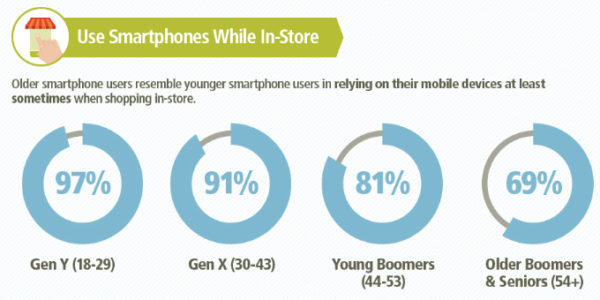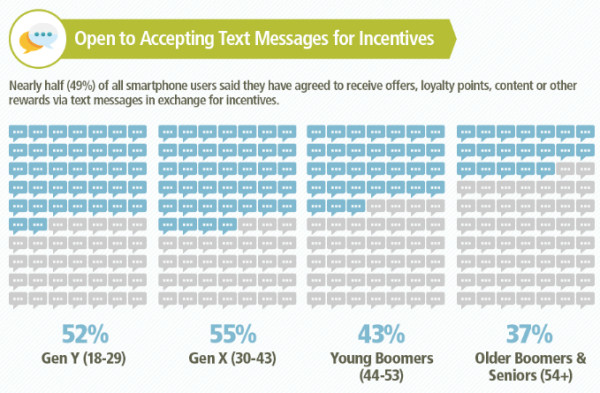Survey: Older Generations Embrace Mobile As Local Shopping Companion
Conventional wisdom tells us that younger generations trump older generations in their use of mobile devices during the local purchasing process. While teenagers use their smartphones at every opportunity to find local businesses, read reviews and scan deals, their parents and grandparents rarely rely on their devices to take advantage of what is increasingly available […]
Conventional wisdom tells us that younger generations trump older generations in their use of mobile devices during the local purchasing process. While teenagers use their smartphones at every opportunity to find local businesses, read reviews and scan deals, their parents and grandparents rarely rely on their devices to take advantage of what is increasingly available via mobile, right?

In fact, in many instances, age is a much smaller than expected factor in determining mobile usage and preference during the purchasing process.
The “Local Mobile Trends Study” surveyed 1,058 smartphone users via Thrive Analytics’ Connected Experience online panel in January 2014. The panel was representative of the U.S. smartphone population, with respondents divided into four groups: Gen Y (18-29-years-old), Gen X (30-43-years old), Young Boomers (44-53-years-old) and Older Boomers & Seniors (54-years-old and above).
The survey’s top-line results are a wake-up call to local marketers about the importance of mobile across all age groups, including older generations. Additionally, they provide valuable context for how smartphone users across all age groups are uniformly using their mobile devices during the local purchasing process.
1. Majority Of Smartphone Users Rely On Devices While Shopping In-Store
While more Gen Y respondents said they were more likely than Older Boomer & Senior respondents to use their smartphones every time they shop in-store (26% vs. 6%), the majority of both age groups said they used their smartphones at least sometimes when shopping in-store (97% vs. 69%).
Key Takeaway: Mobile is already a key part of the local shopping experience for many consumers, and usage will only continue to grow — especially among older generations. This trend provides local businesses with a prime opportunity to reach consumers of all ages via mobile while they are shopping nearby — for example, through their mobile listings, mobile websites, social media, or deal offerings.
Additionally, this fact presents local businesses with the difficult task of ensuring that their mobile presence can balance or beat similar efforts by their competitors. This requires local businesses to build and protect their mobile presences in order to retain and continue to grow their customer bases.
2. Smartphone Users Most Often Turn To Devices To Price Compare & Find Discounts
Smartphone users of all age groups said that price comparisons and discounts were their top reasons for searching via their mobile devices while shopping in-store. The majority of respondents across age groups said they did so to compare prices (60% of Gen Y; 60% of Gen X; 52% of Young Boomers; 51% of Older Boomers & Seniors) and look for coupons or offers (56% of Gen Y; 59% of Gen X; 52% of Young Boomers; 50% of Older Boomers & Seniors).
Key Takeaway: When shopping locally, many smartphone users turn to their devices to help save them money. Local businesses should frame their mobile strategies with this in mind by ensuring that their in-store prices are competitive with what users may find via mobile at nearby businesses and/or online retailers.
Local businesses should also ensure that they offer coupons, discounts and other promotional offers through their mobile websites, local business listings apps, search engines and other platforms that consumers might visit while in-store. These discounts or offers don’t need to be extensive — their mere availability will help reassure consumers that they are getting a deal and lessen the chances they will go elsewhere for their business.
3. Smartphone Users Are Guilt-Free About Using Devices In-Store
Only a small minority of respondents across all age groups said they feel guilty or try to hide using their smartphones while shopping in-store (8% of Gen Y; 10% of Gen X; 8% of Young Boomers; 6% of Older Boomers & Seniors).
Key Takeaway: Local businesses should recognize that their customers have no issue pulling out their mobile devices at any time to compare prices, look up reviews, or search for coupons and deals. In addition to building a strong mobile presence, local businesses should ensure that their employees are prepared to address and answer questions about information customers find via their mobile devices.
For example, customers may use a price scanning app to compare the cost of a product in-store versus what is available online. Local businesses need to develop strategies for how to counter requests from customers to match or beat cheaper prices available elsewhere.
4. Smartphone Users Rely On Devices To Help Them Make Decisions & Be Better Shoppers
The vast majority of respondents said they searched via mobile in-store because it helped them in trying to decide whether to buy something or because it made them be a smarter shopper (88% of Gen Y; 89% of Gen X; 87% of Young Boomers; 85% of Older Boomers & Seniors).
Key Takeaway: Consumers turn to their mobile devices in-store because they want to get the best product, for the best price, from the best business available.
Local businesses need to invest in building mobile presences that highlight the benefits of their offerings, as well as the competitiveness of their prices, the availability of discounts/promotions, and positive reviews. This will enable local businesses to reassure their customers that they are making the best purchase decision possible.
5. Smartphone Users Are Open To Going Elsewhere Based On Information They Discover
Respondents across all age groups said they were willing to stop moving forward with a purchase based on new information they discovered via their smartphone while shopping in-store (65% of Gen Y; 62% of Gen X; 45% of Young Boomers; 37% of Older Boomers & Seniors).
The higher response rate among Gen Y respondents versus respondents from older generations indicates the group’s stronger receptiveness to changing purchasing decisions based on online information.
Of those who said they decided not to buy something based on new information discovered, the most common reason was because they found a better price online (47% of Gen Y; 46% of Gen X; 41% of Young Boomers; 41% of Older Boomers & Seniors), followed by product reviews and better prices at a nearby store.
Key Takeaway: Smartphone users are willing to give up the convenience of making an immediate purchase while in-store in order to go elsewhere – often because they found a lower price.
Once again, local businesses need to ensure customers that their prices are comparable with what is featured online or at nearby stores, and that they have a strategy in place to counter in order to keep the business if customers ask to price-match. They also need to be aware that factors like negative reviews of their business can sway customers to go elsewhere.
6. Smartphone Users Are Willing To Share Location In Exchange For Loyalty Points, Rewards & Deals
Gen Y respondents said they were much more likely than Older Boomer & Senior respondents to “check-in” at a local business or share their location with others via their smartphone (60% vs. 30%).
However, when asked under what circumstances they would be willing to share their location with a brand, retailer or local business, the majority of respondents across all ages agreed that that their top reasons were the ability to gain loyalty points or rewards (67% of Gen Y; 64% of Gen X; 65% of Young Boomers; 62 % of Older Boomers & Seniors) or benefit from an offer or deal (71% of Gen Y; 68% of Gen X; 64% of Young Boomers; 62% of Older Boomers & Seniors).
Key Takeaway: For local businesses, having access to customers’ location is invaluable in helping target mobile advertising on an ongoing basis. And what’s more – obtaining location in exchange for participation in a loyalty program ensures that the consumer will come back to the business repeatedly over time.
Local businesses should take advantage of this trend as a way to build ongoing business and extend marketing opportunities into the future.
7. Smartphone Users Are Open To Receiving Text Messages For Incentives
Nearly half (49%) of all respondents said they have agreed to receive offers, loyalty points, content or other rewards via text messages. While the majority of Gen Y and Gen X respondents said they had agreed to receive text messages in exchange for incentives (52% and 55%, respectively), a comparable share of Young Boomers (43%) and Older Boomers & Seniors (37%) have also agreed to the same.
Key Takeaway: Similar to location, consumers are willing to share their phone number to receive text messages in exchange for incentives.
Local businesses should leverage this trend in order to secure direct access to consumers on an ongoing basis to keep them engaged and informed about their offerings.
Conclusion
Mobile plays a key role in the local shopping experience – not only for younger generations, but for older ones as well.
As smartphones continue to disrupt the local shopping experience, one thing is clear: local businesses have a strong opportunity to build ongoing relationships with those they most want to reach by incentivizing existing and potential customers through mobile offers and discounts. Those businesses that fail to engage via mobile will find themselves playing catch-up with their competitors with significant expense.
Contributing authors are invited to create content for Search Engine Land and are chosen for their expertise and contribution to the search community. Our contributors work under the oversight of the editorial staff and contributions are checked for quality and relevance to our readers. The opinions they express are their own.
Related stories
New on Search Engine Land






